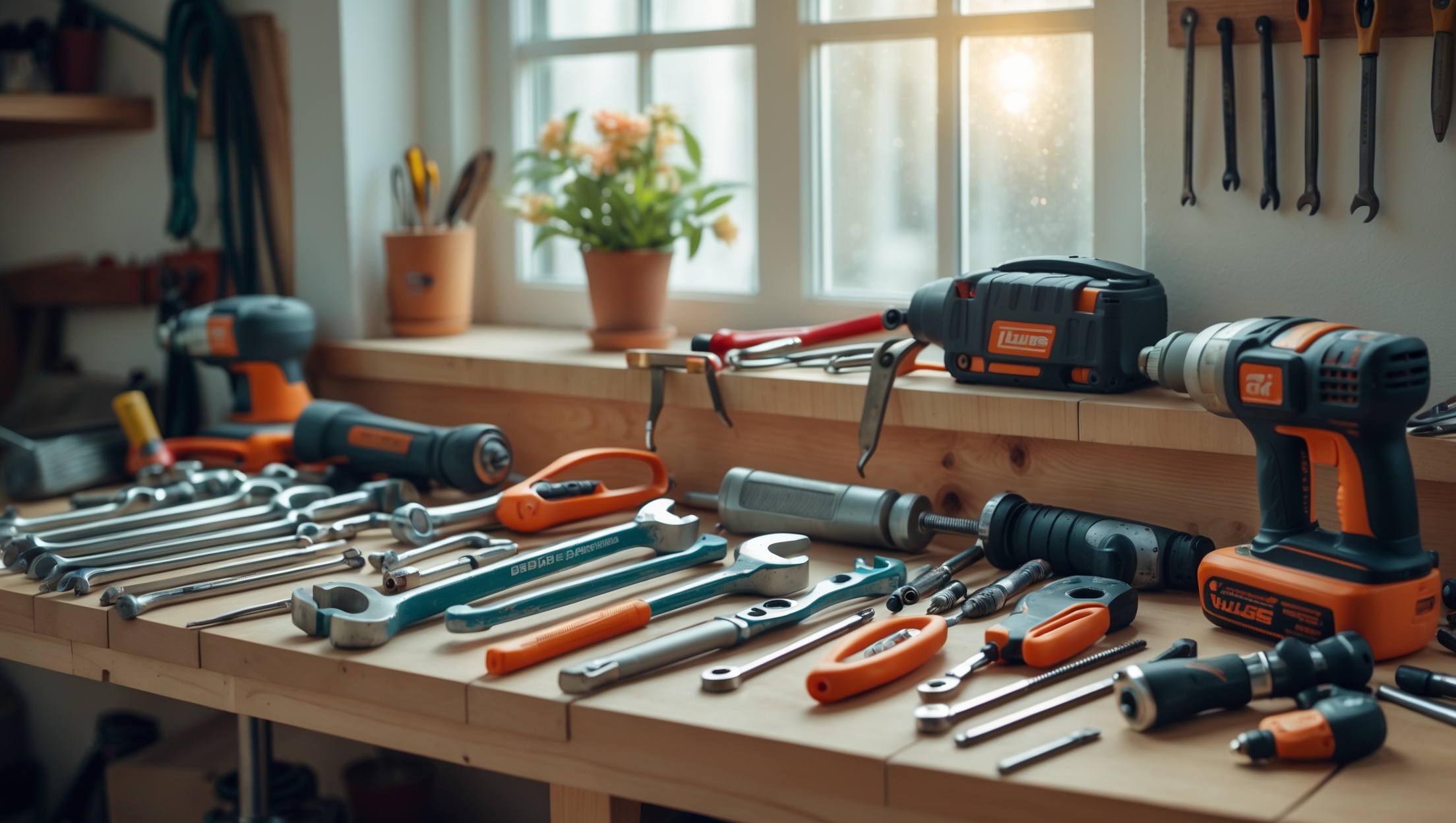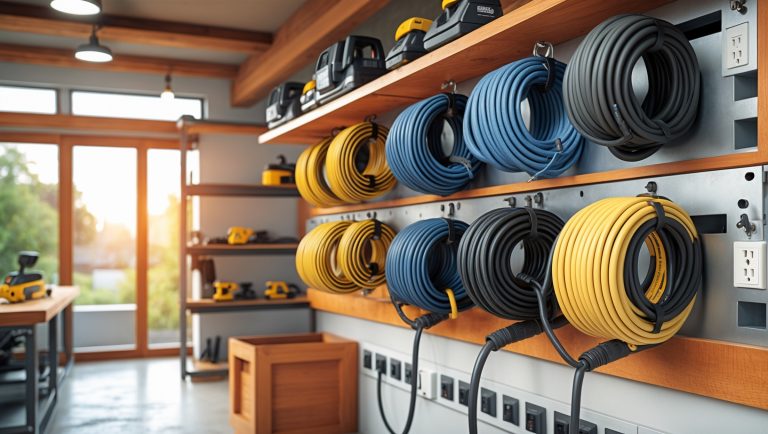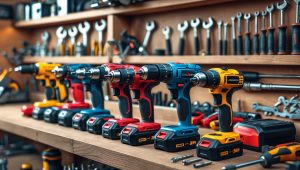Introduction: Why Seasonal Tool Maintenance Matters
Every home DIYer and homeowner knows the frustration of grabbing a tool only to find it rusty, uncharged, or worse—broken. The real secret to smooth home repairs, successful upgrades, and hassle-free maintenance isn’t just about having the right equipment; it’s about keeping it ready for action all year long. Regular, seasonal tool maintenance is the difference between a productive weekend project and a stalled job riddled with setbacks. Neglecting your gear can lead to costly replacements, safety hazards, and wasted time. That’s why having a comprehensive, season-specific checklist is essential—not just for professionals, but for anyone who wants their tools and gadgets to last. In this detailed guide, we’ll break down what you should be doing each season to keep your home equipment in peak condition, covering hand tools, power tools, garden equipment, and even smart gadgets. Whether you’re prepping for spring cleaning, bracing for winter, or somewhere in between, these practical steps will help you avoid common pitfalls, extend tool lifespan, and ensure that when a repair or upgrade calls, you’re always ready to answer.
Spring: Refresh, Inspect, and Prepare
1. Deep Clean After Winter Hibernation
Winter often means tools are stored away, gathering dust and sometimes moisture. Kick off spring with a thorough cleaning:
- Hand Tools: Scrub off dirt, debris, and surface rust using a wire brush and mild detergent. Dry thoroughly to prevent corrosion.
- Power Tools: Use compressed air to blow out dust from vents and moving parts. Wipe casings with a damp cloth; avoid getting internal components wet.
- Garden Tools: Remove caked-on soil and sap. Soak rusty metal parts in vinegar overnight, then scrub clean.
2. Inspect for Damage and Wear
Spring is the prime time to assess your tools for any winter-related damage or wear that may have gone unnoticed:
- Check wooden handles for cracks or splinters. Sand and oil them if needed.
- Look for frayed cords, cracked casings, or loose screws on power tools.
- Sharpen blades on pruners, shears, and lawnmower blades before the growing season ramps up.
3. Battery and Cord Management
Cold weather can sap battery life. Spring is a good time to:
- Charge and cycle all rechargeable batteries. Replace any that won’t hold a charge.
- Check extension cords for nicks, exposed wires, or melted insulation.
4. Lubricate Moving Parts
Lubrication prevents rust and keeps tools operating smoothly. Use a light machine oil on:
- Hinges of pliers and snips
- Joints of adjustable wrenches
- Lawnmower wheels and axles
Summer: Optimize for Heavy Use
1. Monitor for Overheating
High temperatures and extended use can overheat power tools. Prevent premature failure by:
- Allowing tools to cool between uses
- Cleaning air filters and vents regularly
- Storing equipment out of direct sunlight
2. Check Fasteners and Attachments
Vibration from frequent summer projects can loosen screws and bolts:
- Tighten all visible fasteners on saws, drills, and mowers
- Replace any stripped or missing screws
3. Sharpen Blades and Bits
Summer is peak season for both garden and workshop tools:
- Sharpen mower blades, hedge trimmers, and saw blades monthly
- Inspect drill bits and replace any that are chipped or dull
4. Garden Tool Care
- Disinfect pruning tools regularly to prevent plant disease spread
- Oil moving parts after each use in humid conditions to prevent rust
Fall: Prepare for Storage and Transition
1. Deep Clean and Dry Thoroughly
Before storing tools for the colder months, give them another thorough cleaning:
- Wash off dirt, plant sap, and grass clippings
- Dry completely with a towel or leave in a sunny spot
2. Prevent Rust and Corrosion
Moisture is a major concern as temperatures drop:
- Apply a thin coat of machine oil or a rust inhibitor to metal parts
- Store in a dry, well-ventilated area—avoid direct contact with concrete floors
- Use silica gel packs or moisture absorbers in toolboxes
3. Battery and Fuel Management
- Remove batteries from cordless tools and store them in a climate-controlled space
- Empty fuel tanks or add stabilizer to gas-powered equipment to prevent gumming up
4. Inventory and Label
Fall is an excellent time to take stock:
- Inventory all tools and note any missing or broken items
- Label shelves, drawers, and bins for easy access next season
Winter: Protect and Plan Ahead
1. Store Tools Properly
Winter is the off-season for most outdoor projects, but your tools still need care:
- Hang tools when possible to avoid moisture damage from floors
- Use padded cases for sensitive electronics and measurement tools
2. Climate-Controlled Storage
- If possible, keep batteries and delicate gadgets in a heated space
- Avoid exposing power tools to freezing temperatures, which can crack plastic parts or damage batteries
3. Prevent Rodent Damage
Rodents can chew wires and insulation during winter:
- Seal workshop gaps and store cords out of reach
- Use peppermint oil or rodent repellents in storage areas
4. Off-Season Maintenance Tasks
- Disassemble, clean, and lubricate tools not in use
- Order replacement parts or upgrade worn-out tools in preparation for spring
Year-Round: Proactive Habits for Long-Term Tool Health
1. Keep a Maintenance Log
Documenting when and what maintenance you perform helps you spot patterns and plan replacements or upgrades.
2. Safe Storage Practices
- Organize by type and usage frequency for quick access
- Keep sharp tools in protective sheaths or cases
3. Regular Function Tests
Operate each tool briefly every few months, even out of season, to keep lubricants distributed and identify issues early.
4. Clean as You Go
Wipe down tools after every project to prevent buildup and make deep cleaning easier.
Special Section: Smart Home Gadgets and Digital Equipment
1. Firmware and Software Updates
Many modern home gadgets require regular updates for optimal performance and security. Schedule quarterly checks for:
- Smart thermostats
- Wireless security systems
- Wi-Fi enabled power tools
2. Battery Health for Smart Devices
- Keep rechargeable batteries between 20% and 80% to extend lifespan
- Store backup batteries in a cool, dry place
3. Cleaning Sensors and Screens
Use microfiber cloths and manufacturer-recommended cleaners to prevent scratches and keep sensors working accurately.
Printable Seasonal Tool Maintenance Checklist
- Spring: Deep clean, inspect, recharge batteries, lubricate
- Summer: Check for overheating, tighten fasteners, sharpen blades
- Fall: Clean, apply rust inhibitor, inventory, prep for storage
- Winter: Climate-controlled storage, rodent prevention, off-season maintenance
- Year-round: Log maintenance, safe storage, function tests, clean after use
- Smart gadgets: Update firmware, manage battery health, clean screens/sensors
Conclusion: Invest in Tool Health for Hassle-Free DIY
Maintaining your home tools and gadgets isn’t a chore—it’s an investment in the smooth running of every future project. Each season brings unique challenges, from spring’s lingering moisture to winter’s biting cold, but with a structured maintenance routine, you can meet them head-on. A well-cared-for tool is safer, more effective, and will last far longer than one left to rust or gather dust. By following this seasonal checklist, you’ll avoid those maddening last-minute trips to the hardware store, save money on replacements, and enjoy the satisfaction of always having the right tool ready for the job. Your home, your budget, and your peace of mind will thank you. Schedule time each season for these simple steps, and you’ll be rewarded not just with reliable equipment, but with the confidence to tackle any DIY challenge, big or small. Start today—your next project will thank you for it.











I noticed you suggest soaking rusty garden tools in vinegar overnight. Will that work for heavy rust, or should I try something stronger if my tools have been neglected for a few years?
Soaking garden tools in vinegar overnight is effective for light to moderate rust, but if your tools have heavy rust from years of neglect, you may need a stronger approach. After soaking, scrub them with a wire brush to see how much rust is removed. For stubborn rust, try repeating the process or use a commercial rust remover. Finishing with some steel wool can also help get rid of tough spots.
For storing battery-powered tools during the winter, is it better to leave batteries partially charged, fully charged, or remove them completely? The article mentions cleaning, but I wasn’t sure about storage specifics for batteries.
For winter storage, it’s best to remove batteries from your tools entirely. Store the batteries separately in a cool, dry place, ideally at around 50% charge if they’re lithium-ion. This helps prolong battery life and prevents issues from cold temperatures or accidental discharge. Make sure the contacts are clean before storing and check them occasionally during the winter.
My weekends are really tight, so if I can only pick a couple of spring maintenance steps, which ones would you say are the most essential to prevent more expensive repairs down the line?
If you only have time for a couple of spring maintenance tasks, I recommend focusing on cleaning and inspecting your power tools for wear and tear, and sharpening or replacing mower blades. These steps help prevent bigger problems like motor failure or uneven lawn growth, which can be costly to fix later. Prioritizing these areas keeps your equipment running smoothly through the season.
You mentioned using vinegar to soak rusty garden tools overnight in the spring. Is there any risk of the vinegar damaging certain types of metals, or is it safe for all garden tools? Should I use a different method for tools with delicate or painted parts?
Vinegar works well for removing rust from many steel tools, but it can be harsh on certain metals like aluminum or on tools with delicate or painted parts. Prolonged soaking may also remove finishes or dull painted surfaces. For tools with sensitive areas, try gently scrubbing with a baking soda paste or use a rust eraser to avoid damage. Always dry and oil your tools afterward to prevent future rust.
When it comes to deep cleaning garden tools in the spring, you mention soaking rusty metal parts in vinegar. Is there a specific type of vinegar that works best, and how long should I soak them to avoid damaging the metal?
White distilled vinegar is the best choice for soaking rusty metal parts because it’s effective and inexpensive. You should soak the tools for at least 30 minutes, but for heavier rust, a few hours to overnight can help. Just check them periodically, and avoid soaking longer than 24 hours to prevent any potential damage to the metal.
Could you give an idea of roughly how much time a typical seasonal maintenance session should take for an average homeowner’s toolkit? I’d love to get a sense of what to plan for if I want to do a thorough job each spring.
For a typical homeowner’s toolkit, a thorough seasonal maintenance session in spring will usually take about 1.5 to 3 hours. This includes cleaning, inspecting, sharpening, oiling, and safely storing tools. If your toolkit is extensive or you haven’t done maintenance in a while, allow closer to the higher end of that range.
I noticed you mention oiling wooden handles after sanding them down in the spring. Is there a particular type of oil that’s best for this, and is it something I should reapply throughout the year or just during seasonal maintenance?
For wooden tool handles, boiled linseed oil is a popular choice because it penetrates well and helps protect the wood. Tung oil is another good alternative. It’s usually enough to apply the oil once during your main seasonal maintenance, but if you notice the wood looking dry or rough later in the year, it’s fine to reapply as needed. Just make sure the handle is clean and dry before oiling.
Do you have any specific recommendations for keeping power tool batteries healthy during the off seasons, especially if I only use some tools a couple of times a year? I’ve had a few batteries go bad pretty quickly even though I thought I stored them properly.
To help your power tool batteries last longer, store them in a cool, dry place and avoid leaving them on the charger after they’re full. Try to keep batteries at around 40-60% charge during long storage, and recharge them every few months if possible. Also, avoid exposing them to extreme temperatures—both heat and cold can shorten battery lifespan.
Do you recommend any specific products or homemade solutions for cleaning and preventing rust on hand and garden tools, especially for those stored in humid climates during the off-season?
For cleaning tools, a mix of mild dish soap and water works well to remove dirt and sap. After drying, apply a thin coat of mineral oil or boiled linseed oil to metal parts to prevent rust—these are affordable and effective. In humid climates, wiping tools with an oily rag before storing and placing silica gel packets or charcoal in toolboxes can help absorb moisture and further reduce rust risk.
For power tools, you suggest using compressed air to blow out dust from vents and moving parts. Would a regular household vacuum work just as well, or is compressed air definitely better for this kind of cleaning?
A household vacuum can help remove some surface dust from power tools, but compressed air is generally more effective for reaching inside vents and tight spaces. Compressed air can dislodge and blow out fine particles stuck deep within the tool, which a vacuum might miss. If you only have a vacuum, use a narrow nozzle attachment, but for thorough cleaning, compressed air is definitely recommended.
I noticed the article touches on using vinegar to remove rust from garden tools. Are there situations where a commercial rust remover would be better, or is vinegar generally sufficient for seasonal maintenance?
Vinegar is usually sufficient for light to moderate rust on garden tools during routine seasonal maintenance. However, if the rust is extensive, very stubborn, or you want faster results, a commercial rust remover might be more effective. Commercial products are also useful for tools with moving parts or when a deep clean is needed. For most seasonal upkeep, vinegar works well and is safe to use.
For power tools that have been stored in a cold garage all winter, is there any specific maintenance step you recommend before plugging them in again, especially to avoid electrical issues or damage?
Before using power tools stored in a cold garage, let them warm up to room temperature to prevent condensation inside the electrical components. Inspect the power cords and plugs for any cracks or damage, and check for rust or corrosion on metal parts. Also, ensure any moving parts are properly lubricated and clear of debris. If you notice any unusual noise or smell when first powering up, unplug the tool immediately and inspect it further.
The article talks about sanding and oiling wooden handles. What kind of oil works best for tool handles, and is there a major difference between using something like linseed oil versus mineral oil? Does one protect better or last longer?
For wooden tool handles, boiled linseed oil is often preferred because it penetrates deeply, hardens as it dries, and leaves a protective, long-lasting finish. Mineral oil, on the other hand, doesn’t dry or harden and may need more frequent reapplication. Linseed oil generally offers better protection and durability for tools used outdoors or exposed to moisture.
You mention using compressed air to clean power tools after winter—are there any types of tools or specific parts I should avoid using compressed air on? I have a few battery-powered drills and saws and wouldn’t want to damage the internal electronics.
When cleaning battery-powered drills and saws with compressed air, avoid blowing air directly into vents, switches, or open battery compartments, as this could force dust into the internal electronics and cause damage. It’s safest to use compressed air only on exterior surfaces and around easily accessible parts. For stubborn debris near sensitive areas, use a soft brush or a lightly dampened cloth instead.
Your spring checklist mentions using compressed air on power tools to clear out dust. If I don’t have an air compressor at home, are there any affordable alternatives or other safe ways to clean out dust from vents and moving parts?
If you don’t have an air compressor, you can use a can of compressed air, which is affordable and available at most hardware or office supply stores. A small, soft brush like a paintbrush or an old toothbrush also works well for loosening dust, especially in vents and tight spaces. Just be sure the tool is unplugged before cleaning.
I noticed you suggest using compressed air for cleaning power tools. If I don’t have an air compressor, are there other effective methods you’d recommend to remove dust from vents and moving parts?
If you don’t have an air compressor, you can use a small hand-held brush or an old toothbrush to gently loosen dust from vents and moving parts. A can of compressed air, like the kind used for cleaning computer keyboards, is also effective. For stubborn buildup, a soft cloth or a vacuum with a brush attachment can help remove remaining debris without damaging your tools.
For homeowners on a tight budget, do you have suggestions for essential maintenance supplies that offer the best value? For example, is it better to invest in higher-quality cleaning products or focus more on protective tool storage?
For homeowners with a tight budget, it’s usually best to prioritize protective tool storage over high-end cleaning products. Storing your tools properly extends their lifespan by preventing rust and damage, which saves money in the long run. Basic cleaning supplies like mild soap and a brush are often enough for most tools, while a sturdy toolbox, hooks, or even DIY storage solutions can make a big difference in protection.
If I find a power tool that has some winter damage, like a stiff trigger or a battery that won’t hold a charge, is it usually worth trying to fix those at home, or should I just plan to replace it? I’m trying to keep my spending down this year.
If the power tool has minor issues like a stiff trigger, it can often be fixed at home with some cleaning and lubrication. For batteries that won’t hold a charge, sometimes a replacement battery is much cheaper than a whole new tool. Try basic maintenance first—if those steps don’t help and repairs get costly or complicated, then replacement might be the better option.
Is there a way to keep track of seasonal tool maintenance without having to set manual reminders? With kids and a busy schedule, I usually lose track of what has or hasn’t been done each season.
Absolutely, you can simplify seasonal tool maintenance by using dedicated home maintenance apps that track tasks and send automated reminders for you. Some even let you create recurring checklists so you only have to set them up once. Paper checklists hung in the garage or a shared digital spreadsheet with your family are also helpful for quick reference without the need for manual reminders every season.
When you mention using vinegar to soak rusty metal parts on garden tools, is there a specific amount of time you recommend for soaking or any tips to avoid damaging the metal? I don’t want to make things worse accidentally.
When soaking rusty metal parts in vinegar, a good general timeframe is 1 to 12 hours, depending on the level of rust. Check progress every hour or two for lighter rust, and avoid soaking longer than 24 hours to prevent potential metal damage. After soaking, scrub the parts with a brush, rinse thoroughly with water, and dry completely to prevent new rust from forming.
When you mention soaking rusty garden tool parts in vinegar overnight, does that method also work well for larger items like shovels and rakes, or would you recommend a different approach for bigger tools?
Soaking in vinegar is effective for removing rust, but it can be tricky with larger tools like shovels and rakes due to their size. For bigger items, you can either use a large container or try wrapping the rusted area with a vinegar-soaked cloth or towel and covering it with plastic wrap to keep it moist overnight. After soaking, scrub off the loosened rust and dry the tool thoroughly.
When you talk about cleaning hand tools in the spring, is there a particular oil you suggest for wooden handles? I have a few really old hammers and shovels from my dad, and I’d love to keep the wood from cracking but I’m not sure what’s best.
For wooden handles, boiled linseed oil is a classic choice and works well to condition and protect the wood. Apply a small amount with a cloth, let it soak in, and wipe off any excess. Tung oil is another good option. Make sure the handles are clean and dry before oiling, and repeat once or twice a year to keep the wood from drying out or cracking.
I noticed you mentioned using vinegar to soak rusty garden tools overnight. Is there a risk of damaging certain types of metal with this method, or is it safe for all gardening tools?
Soaking rusty garden tools in vinegar is generally safe for most steel tools, as it helps break down rust. However, vinegar can be harsh on some metals, like aluminum or tools with a protective coating, and may cause discoloration or pitting. It’s best to avoid soaking tools with non-steel parts or special finishes. Always rinse and dry tools thoroughly after soaking to prevent further corrosion.
I noticed you mentioned soaking rusty garden tools in vinegar overnight. Is that safe for all types of metal, or are there certain materials I should avoid using vinegar on when cleaning up my equipment in spring?
Vinegar works well for removing rust from many steel and iron garden tools, but it’s not ideal for every metal. Avoid using vinegar on aluminum, as it can cause pitting and discoloration. Also, be cautious with tools that have brass or chrome-plated parts, since vinegar may damage their finish. For those materials, a gentler cleaning method is better.
For hand tools with wooden handles, you mention sanding and oiling them if they’re cracked or splintered. Is there a particular type of oil you recommend for this, or could something like regular vegetable oil work in a pinch?
For wooden handles, it’s best to use a drying oil like linseed oil or tung oil. These oils penetrate the wood, help prevent cracking, and provide a protective finish. Regular vegetable oil isn’t recommended because it can turn sticky or go rancid over time. If you need a quick fix, mineral oil is another safe option until you can get a proper wood oil.
When you mention soaking rusty garden tool parts in vinegar overnight, does this method work well for tools with both metal and plastic components, or should it only be used on all-metal tools?
Soaking rusty garden tool parts in vinegar is best suited for all-metal tools. Vinegar can sometimes weaken or discolor plastic parts, so if your tool has any plastic components, it’s safer to apply vinegar just to the metal areas with a cloth or brush. Make sure to thoroughly rinse and dry the parts afterward to avoid any residue or corrosion.
I have a lot of battery-powered equipment that sits unused through the winter. The article mentions charging and cleaning, but is there a preferred way to store batteries themselves so they don’t lose charge or get damaged between seasons?
For longer storage over winter, it’s best to remove batteries from your equipment and store them separately in a cool, dry place—not directly on concrete floors. Ideally, keep batteries at around half charge and check them every couple of months, topping up if needed. Avoid exposing them to freezing temperatures or excessive heat to help preserve their lifespan and performance.
For power tools, you mention using compressed air to blow out dust from vents. Is there a risk of damaging any sensitive components if I use a standard air compressor? Are there any precautions I should take, especially if my tools are a bit older or haven’t been cleaned in a while?
Using compressed air can be safe if done carefully. Set your air compressor to a low pressure—usually under 30 PSI—to avoid damaging internal components or forcing dust deeper into the tool. Hold the nozzle a few inches away and avoid direct, prolonged blasts at sensitive areas like switches or exposed wiring. For older or neglected tools, inspect for loose parts and accumulated grime before cleaning, as compressed air could dislodge debris into critical areas.
For someone on a tighter budget, are there certain maintenance steps from your seasonal checklist that are absolutely essential to avoid bigger issues down the line, or can I safely skip some without risking tool failure?
If you’re on a tighter budget, focus on the essentials like cleaning your tools after use, lubricating moving parts, and checking for rust or damage each season. These basic steps help prevent major breakdowns. Tasks like deep sharpening or full disassembly can be done less often if you’re careful, but skipping the basics could lead to costly repairs or tool failure.
You mention using vinegar to soak rusty garden tools—does that work for all metal tools, or are there types that shouldn’t be soaked this way? Also, how can you tell if a tool is too far gone to save after winter storage?
Vinegar is generally safe for most steel or iron garden tools, as it helps dissolve rust. However, avoid soaking tools with aluminum parts, as vinegar can cause them to corrode. For tools with wooden handles, don’t submerge the handles to prevent swelling or cracking. If a tool has deep pitting, cracks, or loose parts after cleaning, it may be too far gone to repair safely and should be replaced.
I noticed the checklist mentions using compressed air to clean power tools after winter storage. Is it safe to use a regular air compressor from my garage, or should I be looking for a specialized tool cleaning option?
You can safely use a regular air compressor from your garage to clean power tools, as long as you set it to a moderate pressure (around 30-40 psi) to avoid damaging sensitive components. Just be sure to wear safety glasses and direct the air away from yourself and others. For more delicate tools, a can of compressed air or a small blower can offer more control.
After cleaning and inspecting tools in spring like you suggest, do you recommend any specific steps to protect them going forward, especially if we live in a humid area? I feel like moisture keeps finding a way in no matter what I do.
Moisture can definitely be a challenge in humid areas. After cleaning and inspecting your tools, try applying a light coat of oil or a rust inhibitor to metal parts, which helps block moisture. Store tools in a dry place, use silica gel packs or a dehumidifier in storage spaces, and consider hanging tools to improve air circulation. Regularly check and reapply protective coatings as needed.
Does your checklist recommend any particular type of oil for treating wooden tool handles after sanding, or are household oils like mineral oil good enough? I’ve heard linseed oil is popular, but I’m wondering what actually works best for long-term handle care.
Linseed oil, especially boiled linseed oil, is a popular and reliable choice for treating wooden tool handles because it penetrates deeply and hardens as it dries, offering lasting protection. While mineral oil is safe and easy to apply, it tends to sit on the surface and may require more frequent reapplication. For the best long-term care, boiled linseed oil is generally preferred.
Could you explain what kind of oil should be used for sanding and oiling wooden handles on hand tools, and if there’s a budget-friendly option that still works well?
For sanding and oiling wooden tool handles, boiled linseed oil is a popular choice because it penetrates the wood and provides good protection. It’s widely available and affordable. If you want an even more budget-friendly option, food-grade mineral oil works too, though it may need to be reapplied more often. Just sand the handle smooth, wipe off dust, and rub in your chosen oil, letting it soak before wiping off any excess.
For cleaning rust off my gardening tools in spring, is vinegar safe for all types of metal, or are there certain finishes I should avoid soaking? Also, how long is too long to leave them in vinegar?
Vinegar is generally safe for most plain steel gardening tools but can damage certain finishes like painted, coated, or aluminum surfaces. Avoid soaking tools with wooden handles, as vinegar can harm the wood. For rust removal, soak metal parts for a few hours up to overnight, but don’t leave them for more than 24 hours, as prolonged exposure can cause pitting or further corrosion. Rinse and dry them thoroughly afterwards.
When prepping garden tools in spring, is there a particular type of oil you recommend for wooden handles, or will mineral oil from a grocery store do the job just as well?
Mineral oil from the grocery store works well for conditioning wooden tool handles. It’s easy to find, affordable, and helps prevent the wood from drying out or cracking. If you prefer, you can also use linseed oil, which penetrates deeper and adds extra durability, but for basic maintenance, mineral oil is perfectly suitable for spring prep.
If I have limited time in the spring, which of the checklist steps would you consider most essential for safety and avoiding tool failure later on? Is it better to prioritize deep cleaning or inspecting for damage?
If you’re short on time in the spring, it’s best to prioritize inspecting your tools for damage, loose parts, or wear. Spotting cracks, frayed cords, or dull blades early helps prevent accidents and equipment failure. While deep cleaning is useful, focusing on safety checks and basic lubrication will give you the most protection against unexpected issues during the season.
When cleaning garden tools that have a mix of metal and wooden parts, is it safe to soak the whole tool in vinegar overnight, or should I avoid getting the wooden handle wet?
It’s best to avoid soaking the entire tool in vinegar overnight, especially if it has a wooden handle. Prolonged exposure to moisture can damage or crack the wood. Instead, only soak the metal parts in vinegar to remove rust, and clean the wooden handle with a damp cloth. Afterward, dry thoroughly and apply oil to the wood to protect it.
I noticed you cover hand tools, power tools, and garden equipment. Do you recommend any particular schedule or order for tackling seasonal maintenance if someone has a lot of different tools and limited time?
If time is limited and you have many tools, it helps to prioritize based on the upcoming season’s needs. For example, focus on garden tools before spring, power tools before big indoor projects, and hand tools you use year-round. Breaking maintenance into small sessions, grouped by tool type or storage location, can make the process more manageable.
As a small business owner with both indoor and outdoor equipment, how often should I be repeating these seasonal tool checks if I use some of my tools year-round, not just seasonally? Should I make adjustments for tools that rarely get stored away?
If some of your tools are used year-round, it’s best to shift from a strictly seasonal schedule to a more frequent check—every 2–3 months works well for frequently used equipment. For tools that rarely get stored, focus on regular cleaning, lubrication, and safety checks instead of major seasonal prep. Reserve the deeper seasonal maintenance for those pieces that are used less often or stored for long periods.
If some of my older hand tools have a little rust and the wooden handles are cracked, at what point should I consider replacing them rather than going through the cleaning and repair steps you describe? I’m working with a pretty tight budget.
If the rust is only surface-level and the tool still functions safely, you can often clean it and get more use out of it. For wooden handles, if the cracks are small and the handle feels stable, sanding and oiling might help. However, if handles are deeply split or weakened, or the rust compromises the tool’s strength, replacement is safer. Focus repairs on tools you use most, and replace only when safety or function is at risk.